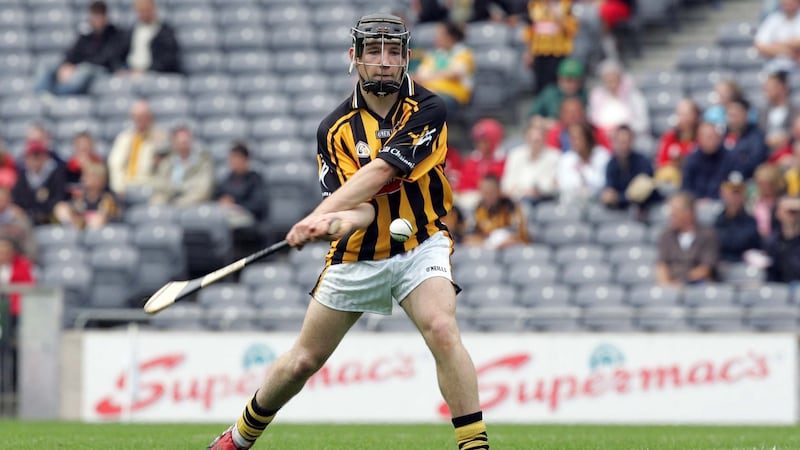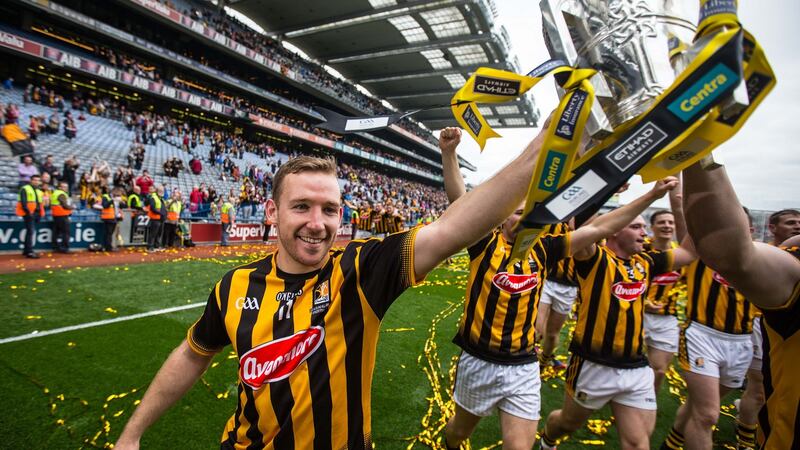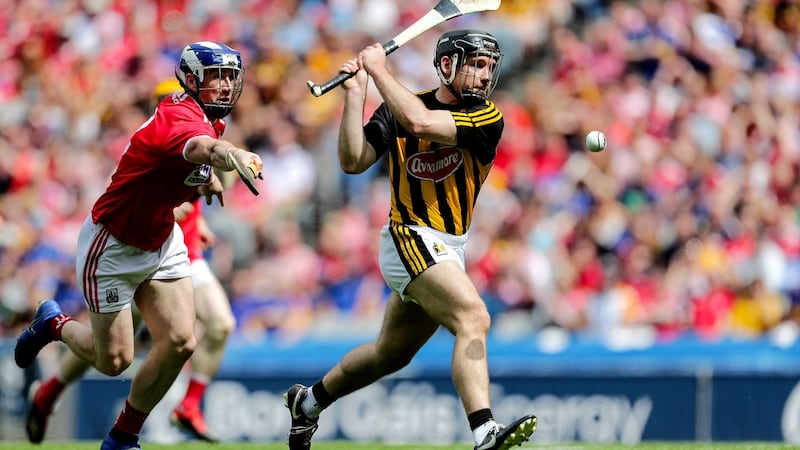The injuries and obstacles and have begun to blur by now; the broken hand, the collapsed lung; the cartilage; the on-going issues with his back. All have been serious, none insurmountable. But it's probable that the combined times spent in treatment and rehabilitation and on the sideline were the source behind the slight shake of the head by Richie Hogan as he came off the pitch 53 minutes into Kilkenny's All-Ireland quarter final win against Cork.
He has reached the stage where every second counts. He had already bagged 1-2 against Cork, his goal coming after he came steaming on to an angled flick from Colin Fennelly. A few minutes after that score, he made light of a bone-shuddering tackle from Bill Cooper which looked set to end his day.
Instead, it was Cooper who struggled to recover, even if Brian Cody had decided that the Danesfort attacker had given it his all a few minutes later. Afterwards, Cody would say that Hogan's contribution to the game had been huge, while reasoning that it would be a huge ask for him to keep that level going for 70 minutes.
“Would he do it?” Cody then asked rhetorically. “Of course he would.”
Driving on has been the key theme of Hogan's 12-year senior career with Kilkenny. As they close in on what would rank as the most unexpected All-Ireland final appearance of the Cody era, Hogan has become emblematic of the virtues and characteristics that the manager has consistently emphasised over those two decades of unflagging internal honesty.
Hogan is 30 years old now. He is sharp and observant and values each game, each season. Famously, he bought his ticket to see Kilkenny win the 2007 All-Ireland semi-final but was selected in the panel for a final that proved to be a lightning assault on this evening’s opposition, Limerick. He was a feted 18-year-old then, through his exploits with St Kieran’s and the minor team. In 2006, he had helped his club win a first Kilkenny junior title since 1930 and hit 1-6 in the All-Ireland final against Clooney Gaels of Antrim.

His potential was vast, but that made him precisely nobody on a fabulously deep Kilkenny senior team that achieved demonic levels of competitive and technical excellence in those periods. Hogan served an apprenticeship under Henry Shefflin, Martin Comerford, Eoin Larkin, Eddie Brennan; he has been the constant presence through the gradual reconfiguration and transition of that team before emerging as its lodestar in 2014 and now, five years later, as a figurehead on a new, young side that is learning on the hoof.
That shake of the head was the visible proof that, if anything, playing for Kilkenny right now means even more than it did when he first arrived on the scene.
“His life at the minute is GAA and hurling,” acknowledges Finbarr Kelly, the current chairman of the Danesfort club. “Richie builds his fitness and body and training around it. He is so conscious of the level he is at. He won’t go out and play unless he is in tip top shape. They have gone to huge efforts this year to correct his injury and hopefully it will last.
“He is a major leader. First and foremost, he really, really loves hurling. If he gets an injury he would work and work at it no end to get back to full fitness. He would be constantly working on his own fitness the whole time. I would say at club level he probably gets more physical contact than where the television cameras are. And less of the proper attention! When he arrives into a club game with umpires picked out of the crowd they are not going to be going up to the referee saying there is someone hassling Richie Hogan. He is well able to mind himself, too.”
He’s never been the biggest. It was never an issue in school, where he was selected for the senior team at just 14, or with the Kilkenny minors for whom he played at 15, firing 1-9 in the 2004 minor final, including the point that edged out Galway. But even though he has worked to develop a compact muscularity to deal with the physical demands of the senior game, the litany of punishments he has taken has been exceptional.
There’s an alternative trajectory to Hogan’s career path which someone with a less singular mind could have followed. After earning a championship start against Offaly in 2008, he learned about the consequences of not grasping it when he failed to finish the game and didn’t feature again as Kilkenny romped to third All-Ireland in succession.
A broken finger and torn ankle ligaments presented a serious disruption to the following two seasons so by 2010 he was still waiting to get another full championship game to add to his clippings. Those were three long and frustrating years spent on the very edge of things for a player who had grown up as the epicentre of his team’s successes.
He didn’t crib or huff or leave: he just kept on training and waiting. In his autobiographical account of the 2011 All-Ireland final win over Tipperary, a reversal of the previous year’s result, Shefflin devotes several paragraphs to a similar play involving Hogan, when Michael Fennelly scored a goal set up by Hogan during added time in the first half.

“With Danesfort, Richie’s used to carrying a massive scoring burden. Basically if he doesn’t get into double figures, Danesfort won’t win. I’ve spoken to him about this, about the need to understand that hurling with Danesfort and hurling with Kilkenny were two entirely different things. With Kilkenny, he needed to lay the ball off a bit more. To realise there were others well capable of scoring. To be fair, Richie’s a quick learner, as you can see in the player he has become today. I can actually see similarities in the development of his career with that of my own.”
Cody has been sparing, if judicious, when meting out individual praise to his hurlers down the years but it is striking that when he has spoken of Hogan in the past, it has often been in relation to the setbacks he has suffered. In April 2012, Hogan damaged ribs and suffered a collapsed lung when he collided with the Galway goalkeeper. It was predicted that his league was over. Four weeks later, he was back on the field for Danesfort and had convinced Cody of his readiness to start the league final.
“He is really determined, he came back strongly,” Cody said then. “He spent three days in hospital, got a drain into the lung - not a pleasant experience. The ribs were worrying because obviously that prolonged the thing but he says he’s not feeling the pain - fair play to him. What I liked about it was that he wanted to play with his club on Sunday. It wasn’t a big county game or anything. I would admire him for that.”
Over the following years, those interruptions and comebacks would become part of the Hogan narrative. A cartilage problem sidelined him for the first three months of the 2014 season. By December, he was the hurler of the year. A 10-point half-time deficit in a league game against Tipperary necessitated a raft of changes: Hogan was told he was going to midfield. There was no preparation or word in his ear; he just got on with it and thrived in the freedom of being able to get on the ball, make a play, take his own score, drop back. “So I don’t really see myself as anything in terms of position,” he said at the end of that glittering year.
The following summer, he was unable to walk on the Friday of the All-Ireland semi-final against Waterford because of prolapsed disc in his back: with painkilling injections, he came through the game. By 2017, he had decided to give up his teaching job in Dublin and take a career break because the constant driving back and forth from Kilkenny was exacting a toll on his back. Nonetheless, he was plagued by back issues throughout 2018. This year, too, he missed most of the league because of back issues. Yet here he was against Cork, defying limited preparation, plundering the opposition, wanting to do more.

The glass ceiling moment of last year’s hurling championship occurred in the 64th minute of Kilkenny’s quarter final game against Limerick in Semple stadium. Limerick had been threatening without quite managing to pull away from Kilkenny and then all of a sudden John Donnelly gathered possession and bore down in front of Nicky Quaid’s goal before spotting Hogan lurking near the right post. Hogan controlled the pass on his hurl, bought space with a feint and then calmly slotted his shot low to give Kilkenny the lead.
If Limerick’s resolve and belief was to buckle, then this was their moment to melt: Kilkenny’s most lethal opportunist striking at the perfect time and an arm raised. It all looked so familiar and inevitable. Over the next 10 minutes, their credentials as All-Ireland material hardened and since then, Limerick have been the team to beat. When they take the field this weekend, though, the Limerick players will carry a sharp memory of just how little time and opportunity Richie Hogan needs to change everything.
“His intelligence for the game is unbelievable,” says Kelly. “Every ball he gets he will do something with it, He is unbelievable for giving a guy a pass into his hand, like, and orchestrating. His biggest problem would be if guys around him weren’t doing what he wants them to do. But he is just thinking the whole time. Even the block down on the corner back the last day . . . he just codded the corner back into believing he had a clear run and then he just pounced on him like a cat.”
So it has come full circle. The precocious talent who had to hustle and wait for his chance has become the senior figure on a young team. Shefflin’s last appearance for Kilkenny was to come on as a substitute for Hogan in the 58th minute of the 2014 All-Ireland final replay. Shefflin’s exit coincided with Kilkenny’s most recent appearance in a final. And if they are to make a return this year; if we are to see the 18th All-Ireland final parade of the Cody era, then chances are that the day will be covered in Danesfort fingerprints.












